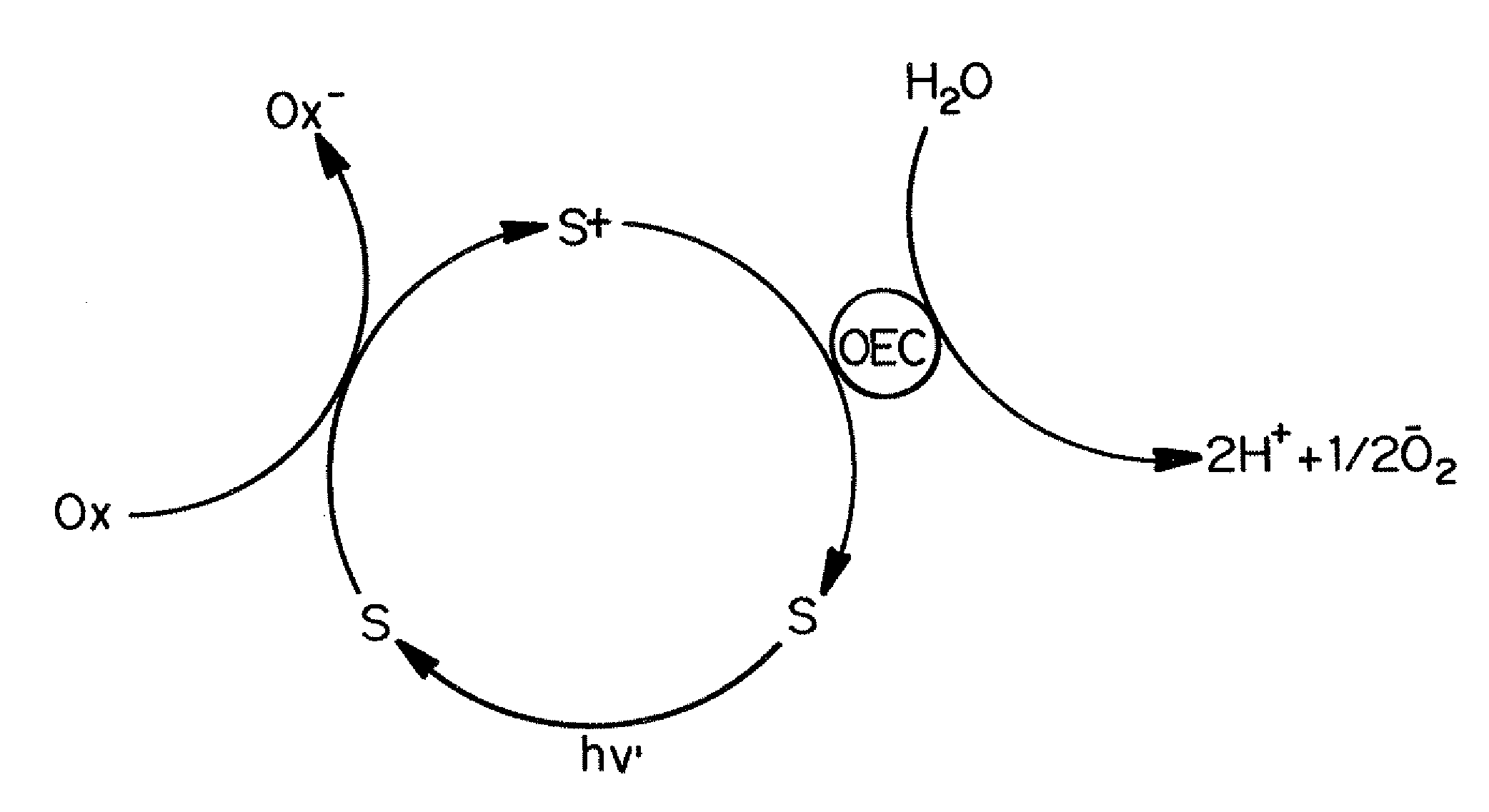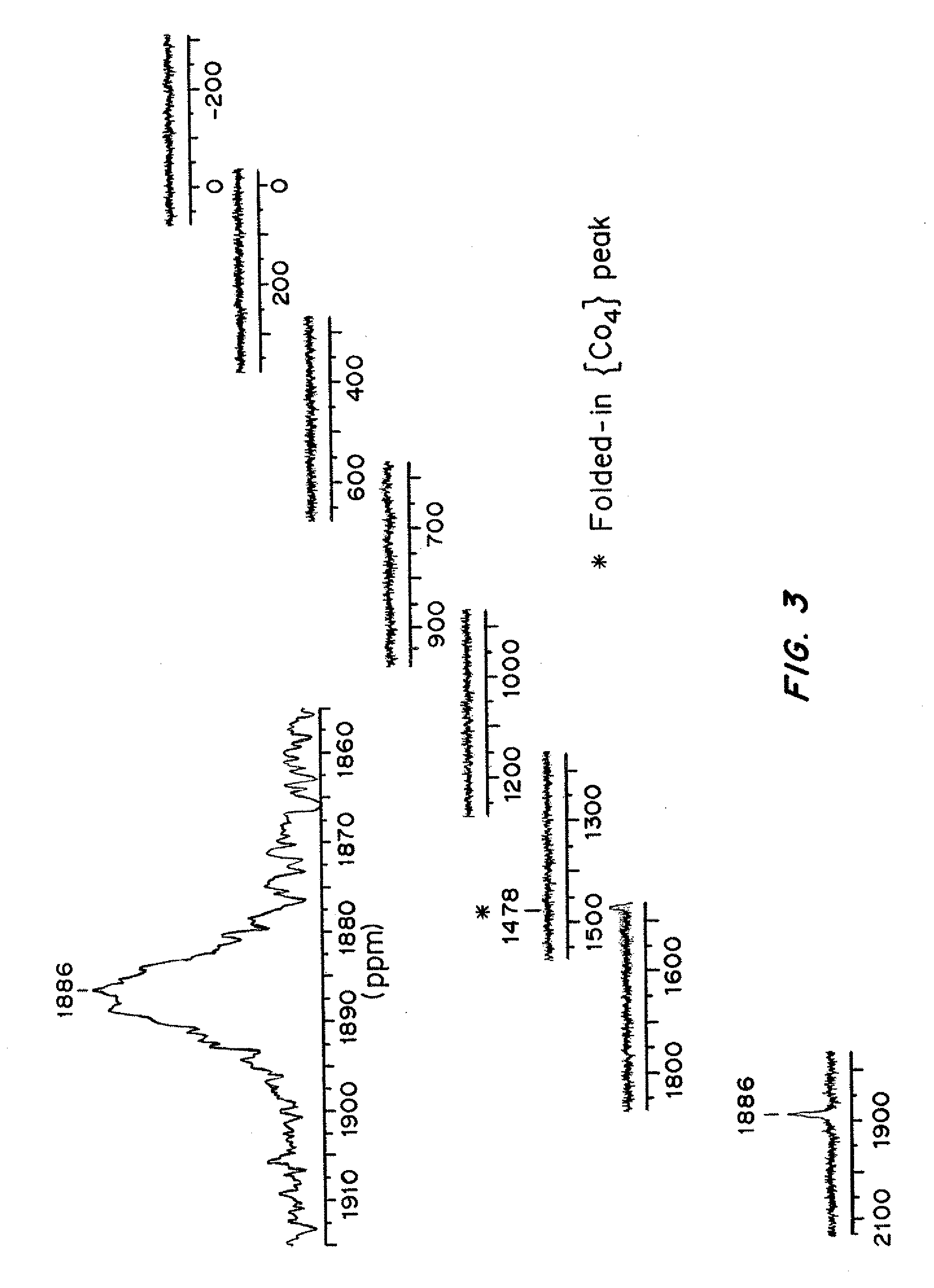Polyoxometalate water oxidation catalysts and methods of use thereof
- Summary
- Abstract
- Description
- Claims
- Application Information
AI Technical Summary
Benefits of technology
Problems solved by technology
Method used
Image
Examples
example 1
Synthesis of Na10[Co4(H2O)2(α-PW9O34)2] (Na-1.)
[0121]Na10[Co4(H2O)2(α-PW9O34)2] was prepared using a procedure for K10[Co4(H2O)2(α-PW9O34)2] described in T. J. R. Weakley, H. T. Evans, J. S. Showell, G. F. Tourné, C. M. Tourné, J. Chem. Soc., Chem. Commun., 139 (1973).
[0122]Na2WO4.2H2O (35.62 g, 0.108 mol), Na2HPO4.7H2O (3.22 g, 0.012 mol), and Co(NO3)2.6H2O (6.98 g, 0.024 mol) were mixed in 100 mL of water. After adjusting the pH from 9 to 7, the purple suspension was refluxed at 100° C. for two hours. A dark purple solution resulted within minutes of heating. The solution was saturated with NaCl and cooled to room temperature. The resulting purple crystals were collected, quickly washed with approximately 30 mL of water, and recrystallized from hot water (35% mass yield based on Co). Thermogravimetric analysis gave 27 water molecules of hydration.
[0123]FT / IR (cm−1): 1037 (m), 939 (m), 882 (w), 767 (w).
[0124]UV-Vis (H2O, pH 3.5 to 9): λmax, 579 nm (ε579=330 M−1 cm−1). 31P-NMR: 1855...
example 2
Oxidation of Water Catalyzed by Cobalt Polyoxometalates in the Dark
[0127]A round-bottom flask with a total volume of ˜17 mL was used to hold 8 mL of aqueous [Ru(bpy)3]3+ solution. A thick-wall tube was used to hold 2 mL of the catalyst in buffered solution. Both containers were capped with a rubber stopper and extensively deaerated by bubbling argon gas through the solution for over 10 minutes. The 2 mL solution in the thick-wall tube was then quickly transferred into the round-bottom flask using a cannula. This afforded 10 mL of reaction solution.
[0128]A fully deaerated 250 μL Hamilton gas-tight syringe was used to withdraw a sample of the gas from the reaction vessel headspace. Aliquots (100 μL) of this gas were immediately injected into a Hewlett-Packard 5890 gas chromatograph fitted with a thermal conductivity detector for analysis. For timed reactions, a stopwatch was used to measure the time elapsed from the time of solution transfer via cannula to the time at which gas was wi...
example 3
Effect of bpy on Catalytic Water Oxidation Activity of 1 and Co(aq)2+
[0131]Reactions were run at ambient temperature in 30 mM NaPi buffer, initial pH 8.0 unless otherwise stated, and 1.5 mM [Ru(bpy)3]3+.
TON=nO2 / ncatalyst;O2-yield=4nO2nRu(bpy)3.
The results are shown in Table 2.
TABLE 2TON and O2 yield for cobalt catalystsCatalystO2concentra-bpyyieldRunCatalysttion (mM)(mM)BufferTON(%)110.00320pH 8 NaPi78.166.7210.00320.3012pH 8 NaPi56483Co(NO3)20.013a0.3012pH 8 NaPi004Co(NO3)20.060b0.3012pH 8 NaPi0.25Co(NO3)20.0130pH 8 NaPi23.4806no catalyst—0pH 8 NaPi00710.00320pH 6.200NaPi / phthalicacidc8Co(NO3)20.0130pH 6.21035NaPi / phthalicacid910.00320.135pH 8 NaPi70.360101 (aged)§0.00320.135pH 8 NaPi71,260.811Co(NO3)20.0130pH 8 NaPi9.833.6(aged)§12CoOd0.00320pH 8 NaPi00aSame theoretical cobalt concentration as 0.0032 mM 1;bSame solid mass as 0.0032 mM 1;ca mixed buffer of 30 mM NaPi and 30 mM phthalic acid at pH 6.2 was used;§a 1 mM stock solution in 30 mM pH 8 NaPi was left for 72 hours before us...
PUM
| Property | Measurement | Unit |
|---|---|---|
| Molar density | aaaaa | aaaaa |
| Molar density | aaaaa | aaaaa |
| Molar density | aaaaa | aaaaa |
Abstract
Description
Claims
Application Information
 Login to View More
Login to View More - R&D
- Intellectual Property
- Life Sciences
- Materials
- Tech Scout
- Unparalleled Data Quality
- Higher Quality Content
- 60% Fewer Hallucinations
Browse by: Latest US Patents, China's latest patents, Technical Efficacy Thesaurus, Application Domain, Technology Topic, Popular Technical Reports.
© 2025 PatSnap. All rights reserved.Legal|Privacy policy|Modern Slavery Act Transparency Statement|Sitemap|About US| Contact US: help@patsnap.com



